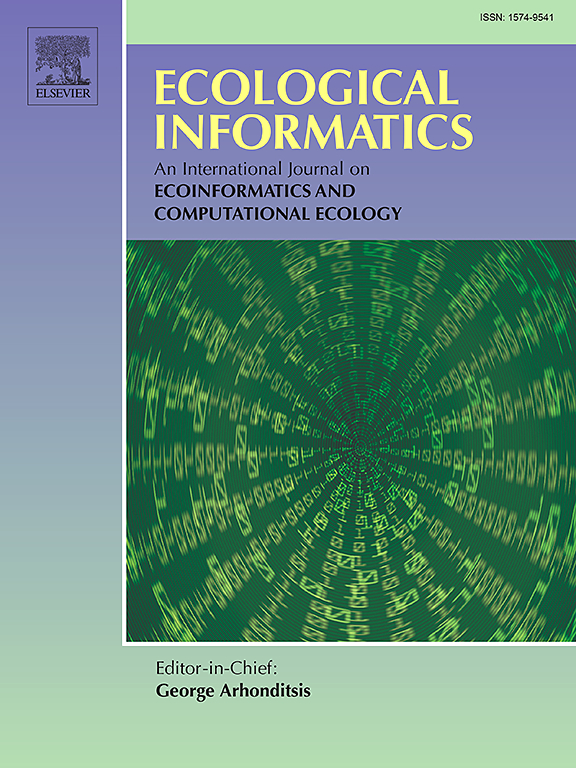高海拔环境下森林垂直结构与黑黑金丝猴栖息地偏好的关系
IF 7.3
2区 环境科学与生态学
Q1 ECOLOGY
引用次数: 0
摘要
了解野生动物行为与栖息地特征之间的关系对于生态和保护至关重要,特别是在偏远、结构复杂的景观中。在这项研究中,我们研究了黑白金丝猴(Rhinopithecus bieti)的季节性和行为特异性栖息地偏好,这是一种中国云南高海拔森林特有的濒危灵长类动物。我们将长期行为观察(2008-2018年)与基于无人机的森林结构激光雷达数据(2022-2023年收集)以及人类和野生动物活动的相机陷阱数据(2017-2018年)相结合,以评估这些因素如何与不同行为和季节的空间使用相关联。使用机器学习模型,我们确定了与R. bieti在家庭范围内的行为一致相关的结构和干扰相关属性。垂直森林结构,特别是冠层高度和植被分层,在干湿季节都与觅食和睡眠地点有很强的关联。这些模式根据行为环境而变化,支持了r.b etti根据季节和结构变化调整其空间使用的观点。人类和牲畜的存在也与饲养和移动期间的栖息地使用负相关。虽然我们的研究结果与半树栖灵长类动物的既定生态预期一致,但它们提供了第一个精细尺度的、空间上明确的栖息地偏好分析之一。我们承认数据集之间的时间不匹配是一种限制,并将我们的结果保守地解释为相关的。尽管如此,本研究强调了将行为、结构和干扰数据结合起来为山地森林生态系统的栖息地保护提供信息的价值。本文章由计算机程序翻译,如有差异,请以英文原文为准。
Associations between forest vertical structure and habitat preferences of black-and-white snub-nosed monkeys (Rhinopithecus bieti) in high-elevation environments
Understanding how wildlife behavior relates to habitat characteristics is essential for ecology and conservation, particularly in remote, structurally complex landscapes. In this study, we examine seasonal and behavior-specific habitat preferences in black-and-white snub-nosed monkeys (Rhinopithecus bieti), an endangered primate endemic to high-elevation forests in Yunnan, China. We combined long-term behavioral observations (2008–2018) with UAV-based LiDAR data on forest structure (collected in 2022–2023), and camera trap data on human and wildlife activity (2017–2018), to assess how these factors are associated with space use across different behaviors and seasons. Using machine learning models, we identified structural and disturbance-related attributes that were consistently associated with R. bieti behavior at the home-range scale. Vertical forest structure, particularly canopy height and vegetation layering, showed strong associations with foraging and sleeping locations across both wet and dry seasons. These patterns varied depending on behavioral context, supporting the idea that R. bieti adjusts its space use in response to seasonal and structural variation. Human and livestock presence were also negatively associated with habitat use during feeding and movement. While our findings align with established ecological expectations for semi-arboreal primates, they provide one of the first fine-scale, spatially explicit analyses of habitat preferences in R. bieti. We acknowledge the temporal mismatch between datasets as a limitation, and interpret our results conservatively as correlational. Nonetheless, this study highlights the value of combining behavioral, structural, and disturbance data to inform habitat conservation in montane forest ecosystems.
求助全文
通过发布文献求助,成功后即可免费获取论文全文。
去求助
来源期刊

Ecological Informatics
环境科学-生态学
CiteScore
8.30
自引率
11.80%
发文量
346
审稿时长
46 days
期刊介绍:
The journal Ecological Informatics is devoted to the publication of high quality, peer-reviewed articles on all aspects of computational ecology, data science and biogeography. The scope of the journal takes into account the data-intensive nature of ecology, the growing capacity of information technology to access, harness and leverage complex data as well as the critical need for informing sustainable management in view of global environmental and climate change.
The nature of the journal is interdisciplinary at the crossover between ecology and informatics. It focuses on novel concepts and techniques for image- and genome-based monitoring and interpretation, sensor- and multimedia-based data acquisition, internet-based data archiving and sharing, data assimilation, modelling and prediction of ecological data.
 求助内容:
求助内容: 应助结果提醒方式:
应助结果提醒方式:


